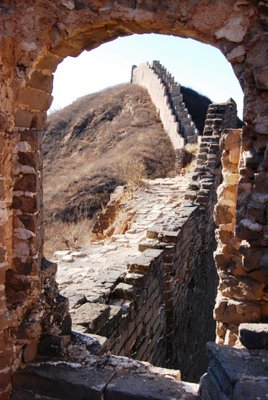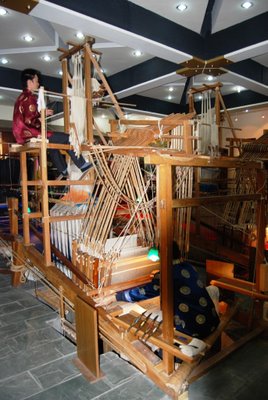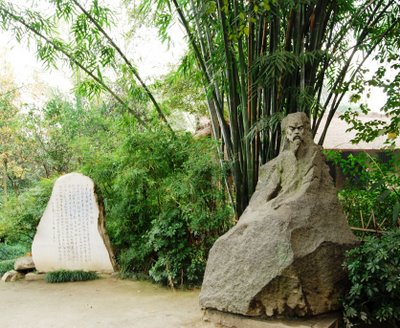On the Rio: Johnny Lang ~ A Quitter Never Wins
Here was my first view of the Great Wall.

How long is the Great Wall? Many dynasties in Chinese history built, rebuilt or extended the Great Wall. The latest construction took place in Ming Dynasty and the length built was over 6,000 kilometres. This is the one often referred to when we talk about the Great Wall. However, if including all the walls built in different dynasties around China, the total length will exceed 50,000 kilometres.The Great Wall is not just a wall. Other defensive works such as forts, passes and beacon towers were built along the Wall to house auxiliary soldiers, store grain and weapons, and transmit military information.
My journey was to hike from Simatai to Jinshanling. The Simatai Great Wall is 5.4 km long (3.6 miles) with all together 35 watchtowers. It would take me a total of 3 1/2 hours to complete the hike.
Built hundreds of years ago, the Simatai Great Wall still retains all its original appearance. It not only incorporates a variety of styles of other parts of the wall, but also displays some unique characteristics. This section of the Great Wall is often described with the following five words: perilous, dense, diverse, ingenuous, and peculiar.
In the valley, the Simatai Great Wall is separated into two parts by the Simatai Reservoir. My hotel, and starting point for the journey, was the far end of the reservoir.

The Simatai Great Wall, with densely-dispersed watchtowers snaking along the mountain ridges, looks spectacular. On the hills with gentle slopes in the west, twenty watchtowers are well preserved.

Over the reservoir is a chain bridge walkway, which I had to make my way down to.

But just when you thought "whew, I made it", you realize that for everyone one step down, there are 2 steps up on the other side (and swear silently under your breath wondering what you got yourself into, knowing there are 3 hours to go!).
The watchtowers on the Simatai Great Wall exhibit a refined design and various structures.

The watchtowers are quite small, but anywhere from 1 to 50 soldiers would live there. Here is a view from one of the watchtowers.

A farmer woman appointed herself as our "local" guide, and we veered off the wall for a while to walk through the neighboring farmlands. This consisted of approximately 3 families, living in broken brick homes, well water must be brought in due to recent highway construction which dried up the local wells. It reminded me most of traveling in the mountains of Romania. So, I ended up buying a Great Wall poster from the "local" guide lady, but she did keep me falling once or twice, so I owed her.
And here I am on the Wall! I can't believe I made it, and it was only Day 1.

Here is some further information on when the Great Wall was built, if you are interested.
Spring and Autumn Period(770-476B.C.)
Wall of Chu State
It is considered as the first part of the Great Wall.
Wall of Qi State
The wall covers a length of 600 kilometers, winding its way through the whole of Shandong Province, from the west in Pingyin County to the east jiao county then reach the Yellow Sea of China.
Warring States (475-221B.C.)
Wall of Qin State
The wall is to built along the north of his frontier at present GansuProvince and Ningxia Hui Autonomous Region
Wall of Zhao State
Locates at present Linzhang County and Cixian County of Hebei Province
Wall of Yan State
Two sections of the Wall were built in this period.
Qin Dynasty(221-207 B.C.)
Wall of Qin Dynasty
The Great Wall first took shape.
Western Han Dynasty(206B.C.-A.D.24)
Wall of Han Dynasty
The longest Wall ever built in China, covering a length of more than 10,000 Li.
Northern and Southern Dynasties
Wall of Northern Wei
Around 1000km of Wall was built during this period
Wall of Eastern Wei
Only around 75km of Wall was built
Wall of Northern Qi
The whole Great Wall was then about 1,500 kilometers (932 miles) long, which was longer than those of former dynasties except Qin and Han.
Wall of Northern Zhou
Renovation of the existing Wall
Ming Dynasty (1368-1644)
Wall of Ming Dynasty
As a result of ever greater efforts of administrator, the Great Wall of the Ming Dynasty, covered some 7,300 kilometres, stretching from the Yalu River on the east to Jiayu Pass on the west becoming an impregnable barrier.











 After the silk museum we went to Remin (People's Park). There was a chrysanthemum flower exhibit. I do not know the woman in the picture.
After the silk museum we went to Remin (People's Park). There was a chrysanthemum flower exhibit. I do not know the woman in the picture.



 Du Fu was a Confusicanist poet of the Tang dynasty and is widely considered to be China's greatest poet. My guide said his poems are memorized in school and he even recited a short one for me. Du Fu lived from 712 - 770.
Du Fu was a Confusicanist poet of the Tang dynasty and is widely considered to be China's greatest poet. My guide said his poems are memorized in school and he even recited a short one for me. Du Fu lived from 712 - 770.



 But it's also important to look at the smaller details else they pass you by.
But it's also important to look at the smaller details else they pass you by.



































 And then turning towards the East, we saw the moon rising.
And then turning towards the East, we saw the moon rising. We returned to Tokyo by the bullet train.
We returned to Tokyo by the bullet train.